- Author Rachel Wainwright [email protected].
- Public 2023-12-15 07:39.
- Last modified 2025-11-02 20:14.
Bradycardia
The content of the article:
- Kinds
- Causes of bradycardia
- Bradycardia symptoms
- Bradycardia in children
- Diagnostics
- Bradycardia treatment
- Consequences and complications
- Prevention
Bradycardia is a change in heart rate in which the heart rate in an adult does not exceed 60 beats per minute, and in children it is below the age limit. Normally, this condition is often found in people who are actively involved in sports. It can also be one of the signs of a heart disorder.
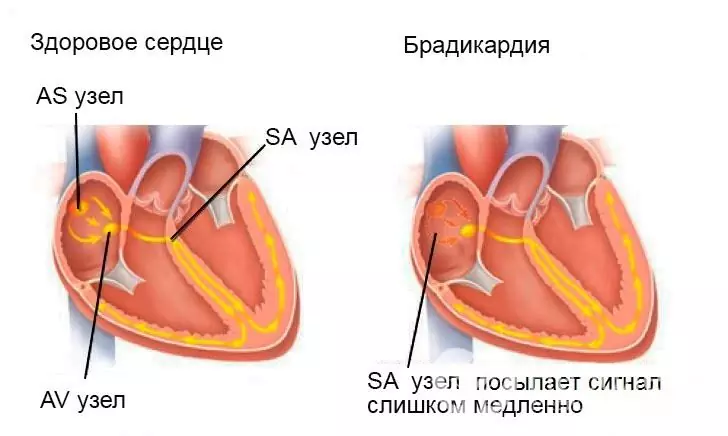
Schematic representation of bradycardia
Kinds
Bradycardia is divided into physiological and pathological. Physiological bradycardia is observed in most athletes. For example, Miguel Indurain, a famous cyclist who won the Tour de France five times, had a resting heart rate of 28-30 beats per minute (at a rate of 60-100). In about 25% of young men, the heart rate does not exceed 50-60 beats per minute.
Also, physiological bradycardia develops during sleep and is manifested by a decrease in heart rate by 25-30% of the original. In this case, its occurrence is associated with the peculiarities of the functioning of the autonomic nervous system. We can talk about physiological bradycardia only in cases where a rare pulse is not accompanied by pathological symptoms (shortness of breath, general weakness, fatigue, chest discomfort, fainting).
Pathological bradycardia develops against the background of pathology. The most common causes of its occurrence are:
- intoxication;
- myocarditis;
- myocardial infarction;
- sclerotic changes in the myocardium.
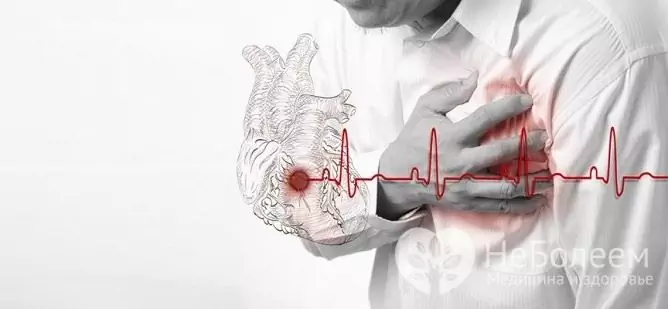
Bradycardia often develops against the background of a previous myocardial infarction
Depending on the pathological mechanism of development of cardiac arrhythmias, there are:
- Bradycardia associated with atrioventricular or sinoatrial heart block. With them, the conduction of the heart impulse between the atria and the ventricles or from the sinus node to the atria is disrupted.
- Bradycardia caused by violations of the automatism of the sinus node.
Given the causes of bradycardia, the following forms are distinguished:
- organic - associated with heart pathologies;
- neurogenic (extracardiac) - due to the effect on the contractile function of the autonomic nervous system;
- toxic;
- medicinal;
- sinus bradycardia of athletes.
In cases where the cause of bradycardia cannot be established, it is called idiopathic.
Causes of bradycardia
The reasons leading to the development of the organic form of bradycardia are:
- cardiosclerosis;
- myocarditis;
- myocardial dystrophy;
- myocardial infarction.
Against the background of these diseases of the heart muscle, fibrotic and degenerative changes occur in the sinus node or pathways, which leads to a decrease in the heart rate.
The organic form of bradycardia is formed against the background of sick sinus syndrome, manifested by a decrease in the generation of electrical impulses in it. This is accompanied by rare, but rhythmic contractions of the heart, i.e., sinus bradycardia or alternating bradycardia and tachycardia. With significant damage to the sinus node, it can lose its automatic function and stop producing electrical impulses.
Damage to the myocardial pathways leads to heart block, as a result of which part of the electrical impulses from the sinus node does not reach the ventricles. This mechanism causes bradycardia.
The dosage form of bradycardia can be caused by taking the following medications:
- Morphine hydrochloride;
- calcium channel blockers (Nifedipine, Verapamil);
- sympatholytic agents (Reserpine);
- β-blockers (Anaprilin, Enam);
- Quinidine;
- cardiac glycosides.
The causes of the extracardiac form of bradycardia can be:
- peptic ulcer of the stomach and duodenum;
- intracranial hypertension (brain tumors or edema, subarachnoid hemorrhage, traumatic brain injury, meningitis);
- Ashner's reflex - a decrease in the heart rate is provoked by pressing fingers on the eyeballs;
- tight collar of clothing, tight tie knot (pressure on the carotid sinus);
- neurosis, accompanied by autonomic dysfunction;
- cardiopsychoneurosis.
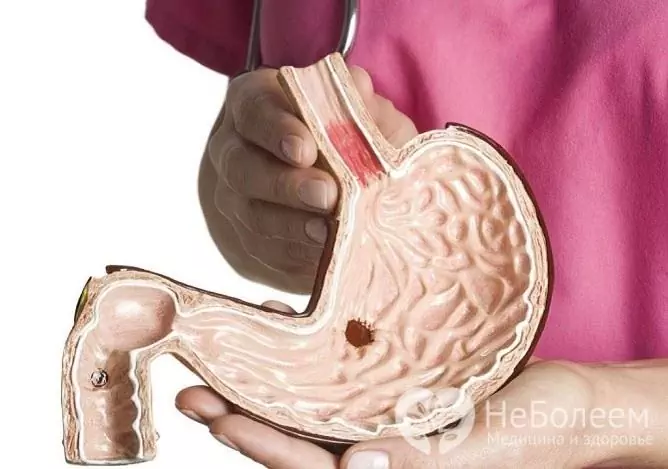
A stomach ulcer can also cause bradycardia.
Another, fairly common cause of bradycardia is insufficient thyroid function (hypothyroidism).
Severe intoxication leads to the development of a toxic form of bradycardia, which can be caused by the following pathological conditions:
- poisoning with organophosphorus compounds;
- typhoid fever;
- uremia;
- hepatitis;
- sepsis.
The toxic form also includes bradycardia associated with hyperkalemia or hypercalcemia (increased concentration of potassium and calcium in the blood, respectively).
The reason for the bradycardia of athletes lies in the peculiarities of the regulation of the heart rate by the nervous system in people who have been involved in sports professionally and for a long time.
Bradycardia symptoms
With moderate bradycardia, blood circulation is not impaired and therefore the patient does not develop any clinical manifestations. Against the background of organic heart disease, with a decrease in heart rate to 40 beats per minute or less, patients develop weakness, dizziness, semi-fainting or fainting. Other symptoms of bradycardia are:
- episodes of confusion;
- transient disorders of visual function;
- memory impairment;
- deterioration in concentration;
- unstable blood pressure;
- chest pain;
- labored breathing;
- fast fatiguability.
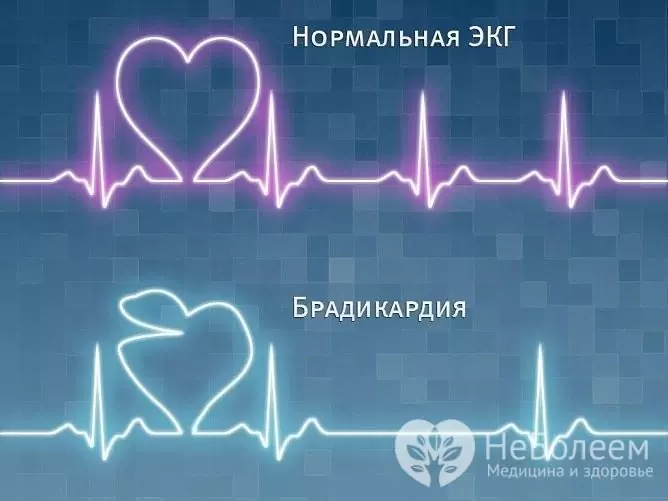
The main symptom of bradycardia is a decrease in heart rate
Bradycardia in children
Bradycardia in children is considered a decrease in heart rate below the values of the age norm. This interpretation is due to the fact that the pulse rate in children changes with age. So, in newborns, we can talk about the development of bradycardia with a decrease in heart rate less than 100 per minute, and in school-age children - below 60 per minute. Parents can assume the presence of bradycardia in children by the following signs:
- dizziness attacks;
- poor appetite;
- increased fatigue;
- general weakness.
There are three types of bradycardia in children:
- Absolute. It is characterized by a constantly slowed down heart rate that does not change under the influence of external and internal factors.
- Relative. A slow heart rate develops under the influence of certain external factors.
- Moderate. A characteristic sign is an increase in heart rate at the time of inhalation.

Sinus bradycardia is most common in children and can be congenital or acquired
In childhood, sinus bradycardia is most common, which is congenital and acquired. The acquired form is associated with an increase in the tone of the vagus nerve, a decrease in the tone of the sympathetic part of the nervous system, or, more rarely, with damage to the sinus node. Also, the development of bradycardia in children may be associated with a violation of the advancement of an electrical impulse along the pathways of the myocardium.
The main reasons for the development of bradycardia in children are:
- congenital diseases of the cardiovascular system;
- diseases of the central nervous system (brain tumors, meningitis, neurosis);
- endocrine pathologies (obesity; myxedema);
- poisoning with heavy metals, in particular lead or its salts;
- taking vagotropic drugs (atropine, quinine);
- overdose of certain medications;
- infectious diseases (typhoid fever, flu, scarlet fever);
- asphyxia of the newborn.
In most cases, sinus bradycardia in children is asymptomatic. Only with a significant decrease in the heart rate in the child appears the corresponding symptoms, due to a decrease in cardiac output and impaired blood supply:
- weakness, lethargy, fatigue;
- lack or decreased appetite;
- dizziness;
- dyspnea;
- chest pain;
- memory impairment;
- fainting;
- pallor of the skin and mucous membranes;
- unstable blood pressure.
The main diagnostic symptom of bradycardia in children is a slow pulse.
Examination and treatment of children with bradycardia is carried out by a cardiologist.
Diagnostics
Signs of bradycardia are detected during examination of the patient and taking anamnesis. With sinus bradycardia, pulses are rhythmic, rare, heart tones have normal sonority, and respiratory arrhythmia is often determined.
When bradycardia is detected, the patient is referred for consultation to a cardiologist. An instrumental examination is assigned, which includes:
- electrocardiography (ECG) - detects signs of atrioventricular or sinoatrial heart block, a decrease in heart rate. If necessary, daily ECG monitoring (Holter monitoring) is prescribed;
- ultrasound examination of the heart (EchoCG) - the method allows you to assess the size of the heart, the presence of foci of degenerative and sclerotic changes in the heart muscle;
- exercise bike ergometry - allows you to assess the change in heart rate under the influence of dosed physical activity;
- transesophageal electrophysiological study (PEEPI) - makes it possible to assess the features of the passage of an electrical impulse through the conducting system of the heart.

An electrocardiogram can diagnose bradycardia
Bradycardia treatment
Physiological bradycardia does not require treatment in the absence of clinical signs of hemodynamic disturbance.
With toxic, extracardiac and organic forms of bradycardia, therapy of the underlying disease is carried out.
The development of drug bradycardia requires a revision of the ongoing drug therapy, discontinuation of the drug that affects the heart rate or correction of its dosage.
With slightly pronounced hemodynamic disturbances against the background of moderate bradycardia, the patient is prescribed preparations of caffeine, ephedrine, belladonna, eleutherococcus extract, tincture of ginseng root. The dosage in each case is determined by the attending physician.
Active treatment of bradycardia is carried out in case of ventricular arrhythmia, heart failure, syncope, hypotension and angina pectoris.
The onset of an Adams-Stokes-Morgagni attack (a sharp hypoxia of the brain associated with a significant decrease in cardiac output against a background of severe bradycardia) is an indication for consultation with a cardiac surgeon in order to determine the advisability of installing an artificial pacemaker (pacemaker) that produces electrical impulses with a given frequency. A constant adequate heart rate, set by a pacemaker, helps to improve the patient's condition, to normalize hemodynamic parameters.
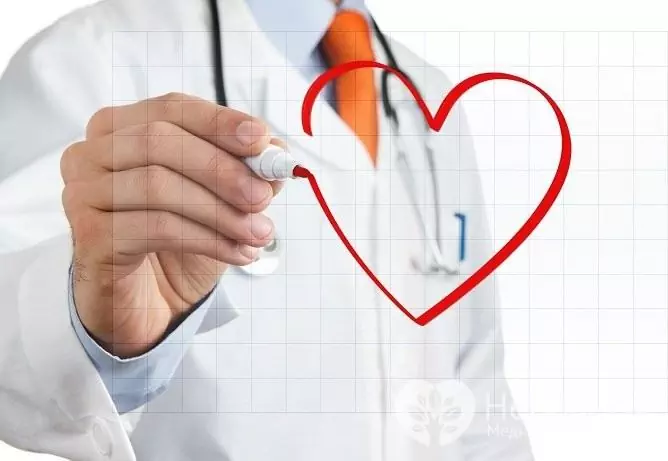
Treatment of bradycardia is aimed at normalizing the heart rate
Consequences and complications
When the heart rate slows down, blood circulation deteriorates, which, first of all, negatively affects the brain tissues, leading to their hypoxia and ischemia. With severe bradycardia, the patient may develop attacks of Adams - Stokes - Morgagni, clinically manifested by loss of consciousness and convulsive syndrome. They can last from a few seconds to several minutes. A prolonged attack can lead to respiratory arrest and cardiac arrest, causing death.
The combination of heterotropic tachyarrhythmias and bradycardia significantly increases the likelihood of thromboembolic complications.
Prevention
Prevention of the development of bradycardia includes the following measures:
- active and timely treatment of organic heart diseases;
- elimination of extracardiac factors that can lead to the development of bradycardia;
- the correct selection of drugs that can affect the heart rate, taking them strictly as prescribed by the doctor in a carefully observed dosage;
- elimination of factors that have a toxic effect on the heart muscle.
YouTube video related to the article:

Elena Minkina Doctor anesthesiologist-resuscitator About the author
Education: graduated from the Tashkent State Medical Institute, specializing in general medicine in 1991. Repeatedly passed refresher courses.
Work experience: anesthesiologist-resuscitator of the city maternity complex, resuscitator of the hemodialysis department.
The information is generalized and provided for informational purposes only. At the first sign of illness, see your doctor. Self-medication is hazardous to health!






